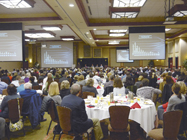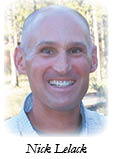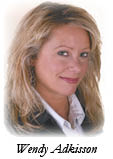
Forecast Breakfast Speakers Point to Improving Trends Driving Growth
Trends in Central Oregon’s real estate market are showing a marked upward trajectory with Bend leading the way through a strong and seemingly sustainable recovery while also building firm foundations for future growth, an annual forum featuring industry experts heard.
A slate of speakers pointed to resurgent fundamentals including building permit and population pick-up, during the well-attended Bend Chamber-hosted Real Estate Forecast Breakfast 2014, held at the Riverhouse Convention Center, while cautioning that both opportunities and challenges lay ahead.
 After a series of false dawns following the last mid-decade downturn, leading indicators now pointed to rebounding activity and values, with opening presenter Deschutes County Development Director Nick Lelack highlighting collaborative efforts between agencies in facilitating investments across the region to lay the groundwork for progress.
After a series of false dawns following the last mid-decade downturn, leading indicators now pointed to rebounding activity and values, with opening presenter Deschutes County Development Director Nick Lelack highlighting collaborative efforts between agencies in facilitating investments across the region to lay the groundwork for progress.
Building on area strengths in tourism, recreation, education, lodging, downtowns and education provided a platform for growth. But, while communities like Redmond, Sisters and La Pine were positioned well to accommodate development, Lelack observed one of the main messages emerging was “Bend is back!”
He added, “Housing starts are one of the leading indicators for the economy and we are seeing a continued rise in the number of permits issued for new homes, and forecasting this recovery to be sustained.
“Commercial project valuations are also up, with a number of signature public and private projects, including the $18 million SHARC center in Sunriver and school construction.”
Educational investments such as the OSU-Cascades campus expansion and over $40 million worth of work at COCC, together with Bend Parks and Recreation District plans to continue to connect trails, enhance parks and improve water safety from the $29 million bond issue, were also set to add to the ramp-up in activity.
Charts for new housing starts graphically illustrated how the previous run up peaked at over 2,000 permits issued for Bend in around 2005 before plummeting to a barely negligible level by 2009, then picked up again from 2010 to around 500 in 2012. That momentum gathered steam to hit over 800 in 2013 and has continued apace into this year.
Lelack said populations in the region were also continuing to rise, with forecasts projecting Deschutes County to “grow by another City of Bend” in the next 12 years. It is estimated the county will continue its pace as one of the fastest growing in the state and is predicted to hit close to 250,000 people by 2025, including over 109,000 in Bend.
Expansion and continued development at established destination resorts like Black Butte Ranch – receiving an $11.5 million facelift – Widgi Creek and Eagle Crest, as well as newer ones like the burgeoning Tetherow project and Pronghorn, with 104 new lodging units coming online, as well as investment on federal lands including Mt Bachelor and Phil’s Trail planned improvements were also bolstering the general picture.
Large lot industrial inventory is also being promoted in Central Oregon with the aid of government grants, particularly in Redmond, which has 30-40 percent water and sewer reserve capacity. Laying the groundwork for sizeable shovel-ready sites allows the region to collectively market a larger available work force.
Paying tribute to the region’s Chambers of Commerce, bodies like Economic Development for Central Oregon (EDCO) and its affiliates, visitor organizations, airports, medical community and overall private and non-profit sectors for programs and services to grow and diversify the economy, Lelack observed, “Permit and population trends combined with significant public and private investments throughout the County are leading a strong and sustained recovery while also building a foundation for future growth.”
REAL ESTATE ACTIVITY ON RISE
 City of Bend Community Development Director Mel Oberst concurred that real estate activity was on the rise, most recently weighted towards the West and Northwest side on the residential front, and estimated that single family starts could match the levels seen in 2005/6 within a couple of years.
City of Bend Community Development Director Mel Oberst concurred that real estate activity was on the rise, most recently weighted towards the West and Northwest side on the residential front, and estimated that single family starts could match the levels seen in 2005/6 within a couple of years.
Almost 700-1000 acres of buildable land in the southeast area of town had not been platted as there was not yet adequate sewer infrastructure in place.
The so-called Southeast Interceptor which would have delivered sufficient sewer capacity to trigger development in that quadrant, as well as delivering services up along 27th Street and toward St Charles Medical Center, was under construction previously but was put on hold in 2012 due to concern over projected costs of building out the system.
Input from the Sewer Advisory Group formed thereafter, and private consultants, has been modeling how work should progress on the City’s overall network, and Oberst was hopeful work on the southeast line would recommence this summer, with completion expected in the next two to three years.
He added, “We are currently bringing on 400-500 platted lots each year while absorption is running around 800-1,000 lots, so you so you can see how critical providing this infrastructure is in helping keep single family housing starts supply and demand in balance.”
Oberst also pointed to a “healthy level” of commercial activity, adding, “To some extent this follows residential – as rooftops are built commercial comes in to support that growth, and the trend line is up.
“I think it was helpful to have policies in place to allow previously planned commercial projects to be extended and renewed to keep them alive and allow time for market dynamics to recover, and some of those projects are underway again.”
COMMERCIAL PROJECTS
Commercial projects currently in review run the whole gamut from student housing to industrial, medical, commercial retail and lodging, including Bend Memorial Clinic’s remodel of the former Lifewise buildings, COCC residential halls, industrial plant expansions for Deschutes and 10 Barrel breweries and the 500 Bond mixed-use project resurrected to include 230 units in the Old Mill District as part of some 800 multifamily units queuing up for entitlements – “the most seen in 10 years” in response to strong demand in that sector.
Oberst said, “The market is strong and permits coming in indicate slow and steady growth for commercial and residential activity as long as we can keep up with infrastructure needed to keep land supply going in relative equilibrium.”
 Gary North, vice president/head of Central Oregon Operations for R&H Construction saw the upcoming surge in commercial and other projects as presenting a potential challenge in finding adequate labor.
Gary North, vice president/head of Central Oregon Operations for R&H Construction saw the upcoming surge in commercial and other projects as presenting a potential challenge in finding adequate labor.
He said, “We are looking at around $180 million in residential projects, another $130 million on the public side and $100 million in private commercial, which adds up to over $400 million worth of work in 2014-16, which is approaching the levels seen in 2006/07.
“We lost around 45 percent of the construction workforce after the last peak, and we used to be able to pull from the (Willamette) Valley to some extent for bigger projects, but, for example, some contractors in the Portland metro area are the busiest they have been for 30-plus years, so you can see we could have a challenge finding enough of a labor force.
“In the last boom you saw a lot of new shingles coming up, so my advice would be if you are rolling out projects to get ahead of the curve in terms of pinn-ing down general contractor schedules and costs.”
Overall, North foresaw cost increases due to the forces of supply and demand, and estimated construction budgets costs could rise around 15 percent.
 Darren Powderly,CCIM, partner with Compass Commercial Real Estate Services observed “growth taking off again” offering numerous opportunities as well as challenges, with ownership of commercial property back in the ascendancy.
Darren Powderly,CCIM, partner with Compass Commercial Real Estate Services observed “growth taking off again” offering numerous opportunities as well as challenges, with ownership of commercial property back in the ascendancy.
He highlighted local priorities as educational excellence, continued support of new business in the acknowledged “start-up haven” of Bend providing a rich source of net job growth, and sustainability in terms of smart growth principles exemplified by projects such as the acclaimed NorthWest Crossing development.
Local commercial was likely entering into the expansionary “Phase 2” of the real estate cycle as part of a broad based recovery featuring declining vacancy and more new construction. Real estate ownership was returning to favor as an investment type with vibrant local industries and increased consumer confidence driving the economy, backed by significant amenities including excellent healthcare provision and enviable lifestyle factors.
HOUSING MARKET

Wendy Adkisson, principal broker with Cascade Sotheby’s International Realty and current president of the Central Oregon Association of Realtors (COAR) began her address by looking back at the dark days of the onset of the recession when the frenzied market screeched to a halt, and, “The phone stopped ringing, buyers backed out of sales in droves and the word on the street was don’t buy.”
Monthly data for closed residential sales in Central Oregon showed a drop from over 650 in June 2006 to just over 200 by January 2008, with the language of distressed sales becoming the new lexicon.
After an excruciating lull stretching into 2010, a more recent snapshot of 2012 versus 2013 showed a 14 percent increase in Bend area (residential under one acre) sales last year, from 1990 to 2026 units, as well as a 30 percent increase in total volume and a 21.2 percent increase in median home prices, from $222,000 to $269,000.
Adkisson said fears of another emerging real estate bubble were allayed as underwriting standards and loan products available were significantly more conservative than the last boom, while a potential rising interest rate environment could dampen buying power.
Projects like a re-energized Tetherow were a “great example” of activity occurring currently in terms of a well-executed long-term vision, but there were concerns over housing supply in certain categories compared to demand, with, for example, Bend only having a current two-month inventory of single family homes priced under $250,000.
She added, “There has been something of a supply and demand disparity but builders saw the trends and have stepped in and banks have somewhat smoothed the way for new construction, so it’s good to see new building going on again.
“We also need to make smart growth decisions in terms of areas like the OSU-Cascades growth and projected Urban Growth Boundary expansion to keep things in balance while nurturing our downtown and urban areas.”
Most sectors were on the rise, though owners of more outdated office buildings may consider undertaking refurbishments to keep pace with changing business environment demands as part of the “Google effect.”
He added, “A big driver of activity is people coming in, and United Van Lines recently named Oregon the number one state for inbound migration.
“I also think it is important that we voice our opinions as a community and provide input as to what we would like to see to continue to create a vibrant economy for the future.”





